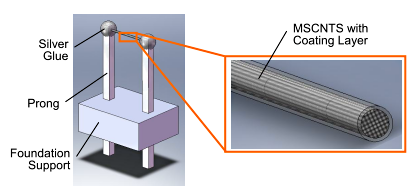High Sensitivity Carbon Nanotubes Flow-Rate Sensors and Their Performance Improvement by Coating
Abstract
:1. Introduction
2. Analysis and Design
3. Experimental Details
3.1. Fabrication
- A thin MSCNTS with diameters of about tens of micrometers are pulled out from a thick as-grown MSCNTS using precise tweezers;
- Then the MSCNTS is suspended straightly between the two 4.4 mm-spacing metal prongs;
- A drop of conducting adhesive is dripped on each contact area and is dried under 120 °C heating conditions for 2 hours for fixing the two ends of the strand and improving the contact characteristics.
3.2. Measurements
4. Conclusions
Acknowledgments
References
- Benjamin, M.; Cosmin, L.; Ronnie, Y.; Yun, S. Development of carbon nanotube-based sensors—A review. IEEE Sens. J 2007, 7, 266–284. [Google Scholar]
- Collins, P.G.; Bradley, K.; Ishigami, M.; Zettl, A. Extreme oxygen sensitivity of electronic properties of carbon nanotubes. Science 2000, 287, 1801–1804. [Google Scholar]
- Li, J.; Lu, Y.J.; Ye, Q.; Cinke, M.; Han, J.; Meyyappan, M. Carbon nanotube sensors for gas and organic vapor detection. Nano Lett 2003, 3, 929–933. [Google Scholar]
- Keat, G.O; Craig, A.G. A carbon nanotube-based sensor for CO2 monitoring. Sensors 2001, 1, 193–205. [Google Scholar]
- Gao, Y.H.; Bando, Y.; Liu, Z.W.; Golberg, D. Temperature measurement using a gallium-filled carbon nanotube nanothermometer. Appl. Phys. Lett 2003, 83, 2913–2915. [Google Scholar]
- Mahanandia, P.; Singh, L.T.; Nanda, K.K. Possible application of carbon nanotube bundles for low temperature sensing. Rev. Sci. Instrum 2008, 79, 053909-1–053909-5. [Google Scholar]
- Liu, L.T.; Ye, X.Y.; Wu, K.; Han, R.; Zhou, Z.Y.; Cui, T.H. Humidity sensitivity of multi-walled carbon nanotube networks deposited by dielectrophoresis. Sensors 2009, 9, 1714–1721. [Google Scholar]
- Zhang, Y.S.; Yu, K.; Xu, R.L.; Jiang, D.S.; Luo, L.Q.; Zhu, Z.Q. Quartz crystal microbalance coated with carbon nanotube films used as humidity sensor. Sens. Actuat. A 2005, 120, 142–146. [Google Scholar]
- Li, C.Y.; Chou, T.W. Strain and pressure sensing using single-walled carbon nanotubes. Nanotechnology 2004, 15, 1493–1496. [Google Scholar]
- Stampfer, C.; Helbling, T.; Obergfell, D.; Schöberle, B.; Tripp, M.K.; Jungen, A.; Roth, S.; Bright, V.M.; Hierold, C. Fabrication of single-walled carbon-nanotube-based pressure sensors. Nano Lett 2006, 6, 233–237. [Google Scholar]
- Shah, R.A.; Rishi, R.P.; Yetunde, B.; Yufeng, M.; Huixin, H. A nonoxidative electrochemical sensor based on a self-doped polyaniline/carbon nanotube composite for sensitive and selective detection of the neurotransmitter dopamine: a review. Sensors 2008, 8, 8423–8452. [Google Scholar]
- Wu, J.; Liu, H.X.; Lin, Z.D. Electrochemical performance of a carbon nanotube/La-doped TiO2 nanocomposite and its use for preparation of an electrochemical nicotinic acid sensor. Sensors 2008, 8, 7085–7096. [Google Scholar]
- Sofia, S.; Nikolas, A.C. Carbon nanotube array-based biosensor. Anal. Bioanal. Chem 2003, 375, 103–105. [Google Scholar]
- Kenzo, M.; Kazuhiko, M. Label-free electrical detection using carbon nanotube-based biosensors. Sensors 2009, 9, 5368–5378. [Google Scholar]
- Victor, T.S.; Wen, J.L. Bulk carbon nanotubes as sensing element for temperature and anemometry micro sensing. Proceedings of IEEE MEMS Conference 2003, Kyoto, Japan, January 2003; pp. 41–44.
- Ghosh, S.; Sood, A.K.; Kumar, N. Carbon nanotube flow sensors. Science 2003, 299, 1042–1044. [Google Scholar]
- Wei, J.Q.; Jiang, B.; Wu, D.H.; Wei, B.Q. Large scale synthesis of long double-walled carbon nanotubes. J. Phys. Chem. B 2004, 108, 8844–8847. [Google Scholar]
- Pan, Z.W.; Xie, S.S.; Lu, L.; Chang, B.H.; Sun, L.F.; Zhou, W.Y.; Wang, G.; Zhang, D.L. Tensile tests of ropes of very long aligned multiwall carbon nanotubes. Appl. Phys. Lett 1999, 74, 3152–3154. [Google Scholar]
- Zhu, L.B.; Xu, J.W.; Xiu, Y.H.; Sun, Y.Y.; Hessa, D.W.; Wong, C.P. Growth and electrical characterization of high-aspect-ratio carbon nanotube arrays. Carbon 2006, 44, 253–258. [Google Scholar]
- Perry, A.E. Hot-wire Anemometer; Oxford University Press: New York, NY, USA, 1982; pp. 19–29. [Google Scholar]
- Bruun, H.H. Hot Wire Anemometry: Principles and Signal Analysis; Oxford University Press: New York, NY, USA, 1995; pp. 7–26. [Google Scholar]
- Zhou, Z.Y.; Li, R.X. Fundamentals of Temperature and Fluid Measurement, 1st ed; Tsinghua University Press: Beijing, China, 1986; pp. 377–386. [Google Scholar]
- Jack, C.; Chang, L. Development and characterization of surface micromachined, out-of-plane hot-wire anemometer. J. Microelec. Syst 2003, 12, 979–988. [Google Scholar]






© 2010 by the authors; licensee MDPI, Basel, Switzerland. This article is an Open Access article distributed under the terms and conditions of the Creative Commons Attribution license ( http://creativecommons.org/licenses/by/3.0/).
Share and Cite
Yang, X.; Zhou, Z.; Wang, D.; Liu, X. High Sensitivity Carbon Nanotubes Flow-Rate Sensors and Their Performance Improvement by Coating. Sensors 2010, 10, 4898-4906. https://doi.org/10.3390/s100504898
Yang X, Zhou Z, Wang D, Liu X. High Sensitivity Carbon Nanotubes Flow-Rate Sensors and Their Performance Improvement by Coating. Sensors. 2010; 10(5):4898-4906. https://doi.org/10.3390/s100504898
Chicago/Turabian StyleYang, Xing, Zhaoying Zhou, Dingqu Wang, and Xiaoli Liu. 2010. "High Sensitivity Carbon Nanotubes Flow-Rate Sensors and Their Performance Improvement by Coating" Sensors 10, no. 5: 4898-4906. https://doi.org/10.3390/s100504898




